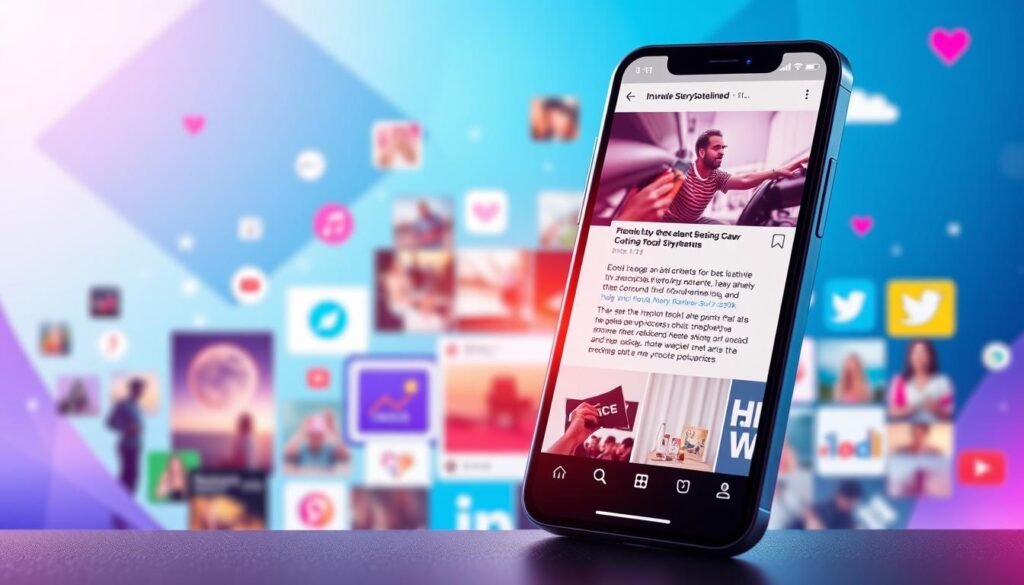
Brand Storytelling makes brands more than just sellers. It turns them into trusted friends. Over 55% of consumers prefer companies with stories they love1. This shows that stories are key in making decisions.
Stories help build trust, which is crucial for 81% of buyers before they buy1. Think of Coca-Cola’s global campaigns or GEICO’s Gecko mascot. These stories create lasting emotional bonds.
Stories are powerful business tools. They are 22 times more memorable than facts1. This makes them great for standing out in a crowded digital space. With 77% of shoppers preferring brands they follow online1, storytelling builds loyalty.
Even small details like user reviews are important. 45% of shoppers avoid products without reviews1.
Key Takeaways
- 55% of consumers prioritize brands with loved stories1.
- Stories boost trust, a key factor for 81% of buyers1.
- Empathetic brands grow faster, per the Global Empathy Index1.
- 92% of consumers want story-like ads2.
- Stories increase conversion rates by 30%3.
Understanding the Power of Brand Storytelling
Brand Storytelling Techniques help companies connect with their customers on a deeper level. It’s different from regular ads because it tells stories that touch people’s hearts. For example, Warby Parker wants to give everyone access to glasses, which is a big deal since over 1 billion people worldwide can’t see clearly4.
This kind of story builds trust and shows the brand’s purpose. It makes people want to support the brand.
What is Brand Storytelling?
It’s about telling a company’s story, including where it started, what it believes in, and where it’s going. Burt’s Bees Foundation, for instance, gave $5 million to help green spaces4. This shows how brands can live their values through action.
Being real and true to oneself is key. It helps a brand stand out in a busy market.
Why It Matters for Businesses
Businesses that tell stories see real benefits. Over 45% of people don’t buy things without checking reviews first4. This shows how important it is to share real stories.
Big companies like Nike spend a lot on marketing to tell inspiring stories4. Even Airbnb, with 646,000 YouTube subscribers, knows the power of visual stories4. Stories that touch our hearts can even make a company more money—30% more, to be exact5.
Key Elements of a Compelling Story
Good stories have characters we can relate to, a clear story line, and themes that match the brand’s values. It’s all about feeling something, because we remember stories better than facts5.
Using real people’s stories and focusing on things like helping the planet can make a brand’s story even stronger5. Patagonia, for example, tells stories that make people want to join their community.
Building Your Brand’s Narrative
Effective brand narrative strategies start with a clear framework. The brand storytelling framework has four pillars: people, places, purpose, and plot. These pillars guide every decision, making stories feel genuine and memorable.
Identifying Your Core Message
Start by figuring out what makes your brand unique. Ask yourself: What problem do you solve? How do your customers benefit? For example, Airbnb’s core message is about belonging, not just travel. Over 40% of consumers leave brands that ignore their values6, so being clear is key.
Defining Your Brand Voice
A consistent voice builds trust. Use language that reflects your audience’s values. Whether friendly, professional, or adventurous, your tone shapes how people see you. Stories that touch emotions influence 68% of buying decisions7. Tools like sentiment analysis help refine your voice over time.
Aligning With Customer Values
Listen to what your audience cares about. Social listening tools track mentions and trends, showing what’s missing. Greenpeace UK used this to align campaigns with environmental concerns, boosting engagement. When values align, loyalty grows.
| Tool | Features | Benefits |
|---|---|---|
| Hootsuite | Sentiment analysis, social listening | Track brand perception trends |
| Brandwatch | Real-time sentiment tracking | Identify emerging customer preferences |
| Mention | Brand monitoring, competitor analysis | Align narratives with market shifts |
By following these steps, brands like Target and Calm have built loyal followings. Every choice, from voice to values, strengthens the narrative. Start small, test, and refine to see results.
The Role of Empathy in Storytelling
Empathy makes brand messages connect with people. The Global Empathy Index shows empathetic brands grow fast. They build loyalty through emotional connection8. Good storytelling is about feeling what customers feel and need.
Connecting on an Emotional Level
Stories that reflect our lives stick with us. Emotions make our brains work harder than facts8. This makes people want to share the story.
Dove’s Real Beauty campaign showed how self-image struggles are common. It started global talks. Emotional stories build communities, not just sell.
Using Customer Stories for Authenticity
Real customer stories make brands seem genuine. World Wide Technology’s storytelling program boosted employee pride and its ranking9. Sharing true stories makes brands relatable.
80% of people want to hear brand stories8. When brands share real emotions, they form strong bonds. This makes people feel valued and loyal.
Crafting Relatable Characters
Characters make stories real, turning brands into relatable people. Storytelling for brands works best when people see themselves in the story. By making customers the heroes, brands earn trust and loyalty. For example, Warby Parker shows its customers as smart shoppers who find quality without spending too much—showing how heroes shape how we see things10.
Creating Protagonists That Resonate
Good brand storytelling tips match characters with audience values. 70% of marketers use detailed personas to make sure characters fit their target audience11. When people see their goals in stories, trust grows. A study found 61% of buyers like brands that share relatable stories10. Being real is key: 80% of consumers prefer brands that share their values11.
The Importance of Conflict and Resolution
Conflict makes stories interesting by showing how products solve problems. By highlighting challenges like “high costs” or “complex choices,” brands can show how they help. Stories with clear struggles and solutions can increase engagement by up to 300%10. For example, a company might say its product is the “hero’s tool” to overcome challenges.
| Story Element | Impact |
|---|---|
| Protagonist Alignment | 61% more purchases10 |
| Narrative Conflict | 300% engagement increase10 |
| Authentic Characters | 80% higher trust11 |
Stories without conflict are dull. By making customers the heroes facing real challenges, brands win their audience’s support. Remember, characters make brands feel personal. Use these brand storytelling tips to create stories where customers and your brand shine together.
Visual Storytelling Techniques
Visual storytelling turns abstract messages into lasting memories. With our short attention spans, visuals are key to breaking through digital clutter.
The Use of Imagery and Design
Color psychology is crucial—Apple uses simple colors to show innovation and ease12. The Rule of Thirds puts important elements where our eyes naturally go, making visuals more impactful12. Infographics can increase web traffic by 12% and social shares by three times compared to text13.
Avoiding too much clutter is important; too many visuals can drop engagement by 40%14.
| Element | Description | Impact |
|---|---|---|
| Color Grading | Evokes emotions and brand identity12 | 89% audience retention13 |
| Video Structure | Three-act setup (setup, conflict, resolution) keeps viewers hooked12 | 53% of users want more video content13 |
| Mobile Optimization | Responsive design avoids Google penalties14 | Reduces bounce rates by 45%14 |
Incorporating Video for Engagement
Short videos on TikTok or Instagram Reels tell stories quickly. Honda’s ads used emotional visuals to boost sales by 30%14. Real videos with relatable characters build empathy—89% of viewers are more likely to buy after watching13.
Testimonials in videos increase trust and memory. Dynamic angles and metaphors make complex ideas 60% more memorable12.
Platforms for Storytelling Delivery
With 66.2% of the world online and 5.04 billion active on social media15, picking the right platforms is key. Each one needs its own story to make a big impact. Social media loves short, visual stories.
Dating app Thursday uses Instagram to share success stories. This builds a community through relatable posts16. It turns followers into brand advocates by sharing real stories.

Email marketing builds strong connections with personalized stories. The Copy Posse newsletter by Alex Cattoni mixes personal stories with business tips. It shows email can build trust over time16.
Blogs let brands share their message and boost SEO. Patagonia’s blog has kept its environmental mission alive for decades16. Being consistent is important: 64% of consumers like brands that share clear, purpose-driven stories16. This builds loyalty and drives sales.
Adjust your storytelling for each platform. Use Instagram for quick stories, emails for deeper tales, and blogs to show your expertise. By matching your stories with each platform’s strengths, you’ll get noticed without losing your message.
Measuring the Impact of Your Story
Tracking your brand’s storytelling success begins with a clear brand storytelling framework. It’s about knowing what works and aligning it with your business goals. Tools like Google Analytics help see how stories lead to sales. CRM systems show how well you keep customers coming back.
Time spent on web pages or video views shows if people are really into your story17.
Key Metrics to Track Engagement
Metrics like social shares, click-through rates, and conversion rates are key. When people engage, it means your story is hitting the mark. Conversion rates and customer lifetime value (CLV) show if stories lead to sales.
Sentiment analysis tools measure how your story makes people feel. This shows if your story builds positive feelings17. Platforms like Instagram or email campaigns use open rates and shares to show how well your story is doing17.
Analyzing Customer Feedback
Surveys and reviews help find out if people feel a connection. 81% of buyers trust brands they feel a connection with18. So, feedback is key to seeing if your story is building trust.
A/B testing different story angles helps make your story even better. Regular analysis compares your performance to others in your field. This keeps your strategy sharp17.
Tips for Continuous Improvement
Effective brand storytelling needs to be flexible. People want new stories but still want to see your values. Try out different ideas and see what works best. For example, 65% of people remember stories better than facts19, so it’s important to keep improving your stories based on what people say.
Iterating on Your Brand Story
Spotify’s Wrapped campaign started as simple playlists but grew into amazing AR experiences. They change things up every year to keep it fresh. This made social media engagement jump by 30%19.
Testing different versions of your story can help you find what people like. For instance, adding quotes made users more active by 25%20. Always listen to what your customers have to say to find out what they’re missing.
| Year | Change | Result |
|---|---|---|
| 2016 | Initial launch with top songs | 30% engagement boost19 |
| 2020 | Added interactive polls | 45% more shares19 |
| 2022 | AR visualization features | 22% retention increase19 |
Staying Relevant in Changing Markets
Budweiser’s “Whassup?” campaign changed to focus on mental health during the pandemic. This move increased engagement by 23%19. Being real is key—Nike’s “Dream Crazier” campaign used emotional stories to talk about equality20. Keep an eye on how people are interacting with your content to see if you need to adjust.
Being open builds trust. Sharing what goes on behind the scenes can make people happier by 25%19. Look at successes like Coca-Cola’s TikTok hits for inspiration to keep your story fresh.
Case Studies: Successful Brand Storytelling
Brands like Spotify and Dove show how storytelling turns abstract ideas into stories we remember. These stories build loyalty and trust. They prove that narrative branding works across different industries.
Examples of Brands That Excel
Spotify’s Year-End Recap turns user data into personal stories. Their Wrapped campaign has become a big part of our culture21. Dove’s Real Beauty campaign has helped millions, linking the brand to social change21.
Apple’s “Think Different” campaign, started in 1997, made them known as innovators. This helped them beat their competitors, even when Microsoft was strong22. Manchester City’s Georgia Stanway campaign showed her strength, increasing fan support through real athlete stories23.
Lessons Learned from Industry Leaders
Being consistent is key: Purdue University’s viral video got 28 million views by being creative during tough times21. Emotional stories, like WWF’s climate campaigns, get people to act more than facts do23. Patagonia’s stories about caring for the environment build trust over time.
Even small brands can learn from these examples. Be true to yourself, connect with people on an emotional level, and let your mission guide your stories.
FAQ
What is brand storytelling?
Why is brand storytelling important for businesses?
What are the key elements of a compelling brand story?
How can I build my brand’s narrative?
What role does empathy play in brand storytelling?
How can I create relatable characters in my brand story?
What visual elements enhance brand storytelling?
How do I choose platforms for storytelling delivery?
How can I measure the impact of my brand storytelling?
How should I continuously improve my brand storytelling?
Can you provide examples of successful brand storytelling?
Source Links
- Mastering Brand Storytelling: Strategies for Creating Emotional Connections – Clarity Messaging – https://www.claritymessaging.com/blog/brand-story-strategy
- Mastering the Art of Brand Storytelling – https://www.ewrdigital.com/blog/mastering-the-art-of-storytelling
- Mastering Brand Storytelling: Strategies and Examples – https://www.engagebay.com/blog/brand-storytelling/
- Brand Storytelling: What It Is and Why It Matters – https://www.acquia.com/blog/brand-storytelling
- The Power Of Storytelling In Modern Marketing – https://www.forbes.com/councils/forbescommunicationscouncil/2024/08/05/the-power-of-storytelling-in-modern-marketing/
- Brand storytelling: Creating a story that resonates – https://sproutsocial.com/insights/brand-storytelling/
- Brand Storytelling: 10 Strategies for Maximum Impact – https://storychief.io/blog/brand-storytelling-techniques-audience-engagement
- How to Use Empathy in Your B2B Brand Storytelling – https://www.marketingprofs.com/articles/2020/43172/how-to-use-empathy-in-your-b2b-brand-storytelling
- How Employee Storytelling Helps Build Empathy at Work – https://www.greatplacetowork.com/resources/blog/how-employee-storytelling-helps-build-empathy-at-work
- Brand Storytelling: A Comprehensive Guide to Crafting Compelling Narratives | The Successful Founder – https://thesuccessfulfounder.com/brand-storytelling-a-comprehensive-guide-to-crafting-compelling-narratives/
- 5 Best Techniques for a Compelling Agency Brand Narrative – Seven Figure Agency – https://sevenfigureagency.com/5-best-techniques-for-a-compelling-agency-brand-narrative/
- Visual Storytelling Techniques for Impactful Brand Promotion – https://barkingsquirrelmedia.com/video-production-blog/visual-storytelling-techniques-for-impactful-brand-promotion/
- The Art of Visual Storytelling in Marketing – https://foundationinc.co/lab/visual-storytelling
- 8 tips for powerful visual storytelling – https://shorthand.com/the-craft/8-tips-for-great-visual-storytelling/
- Shorthand | Beautifully simple storytelling for the web – https://shorthand.com/
- Brand storytelling – What it is and how to do it – https://www.frontify.com/en/guide/brand-storytelling
- Measuring the Impact of Storytelling on Your Marketing Success – https://charleslange.blog/2024/09/10/measuring-the-impact-of-storytelling-on-your-marketing-success/
- How to Measure the Impact of Brand Storytelling | EWR Digital – Proven, Top-Rated WordPress Marketing & SEO Agency – https://www.ewrdigital.com/blog/measuring-brand-storytelling-success-guide
- Mastering Marketing Storytelling: Techniques to Engage Your Audience – https://www.launchnotes.com/blog/mastering-marketing-storytelling-techniques-to-engage-your-audience
- Digital Brand Storytelling: The Art of Crafting Compelling Narratives – https://millermedia7.com/the-art-of-digital-brand-storytelling-how-to-craft-compelling-narratives-in-a-noisy-digital-world/
- 17 examples of strong brand storytelling (updated 2024) – Toast Studio – https://www.toaststudio.com/en/articles/pg-volvo-and-other-examples-of-strong-brand-storytelling/
- 5 Brand Storytelling Examples To Learn From – https://stevens-tate.com/articles/5-brand-storytelling-examples-to-learn-from/
- 10 Powerful Examples of Brand Storytelling – https://shorthand.com/the-craft/examples-of-brand-storytelling/index.html





20 replies on “Mastering Brand Storytelling: Proven Techniques to Engage Customers”
Hmm is anyone else having problems with the pictures on this blog loading? I’m trying to figure out if its a problem on my end or if it’s the blog. Any feed-back would be greatly appreciated.
Youre so cool! I dont suppose Ive learn something like this before. So good to search out any person with some authentic thoughts on this subject. realy thanks for beginning this up. this website is something that’s wanted on the internet, somebody with somewhat originality. helpful job for bringing one thing new to the internet!
Good post however I was wondering if you could write a litte more on this subject? I’d be very grateful if you could elaborate a little bit more. Thanks!
You are my breathing in, I have few blogs and very sporadically run out from brand :). “To die for a religion is easier than to live it absolutely.” by Jorge Luis Borges.
I truly appreciate your technique of writing a blog. I added it to my bookmark site list and will
I am only commenting to let you know what a fabulous encounter my wife’s princess developed using the blog. She came to find a wide variety of issues, which include what it is like to have an ideal teaching style to make a number of people just fully grasp several specialized topics. You undoubtedly exceeded readers’ desires. Many thanks for coming up with those insightful, trustworthy, explanatory not to mention fun thoughts on that topic to Evelyn.
Aw, this was a very nice post. In concept I wish to put in writing like this moreover – taking time and precise effort to make an excellent article… but what can I say… I procrastinate alot and in no way seem to get something done.
Every sentence here adds value.
Your place is valueble for me. Thanks!…
Thankyou for all your efforts that you have put in this. very interesting information.
Hello, you used to write fantastic, but the last several posts have been kinda boring… I miss your tremendous writings. Past several posts are just a bit out of track! come on!
Nice read, I just passed this onto a friend who was doing a little research on that. And he actually bought me lunch as I found it for him smile So let me rephrase that: Thanks for lunch!
I real lucky to find this internet site on bing, just what I was searching for : D too saved to fav.
good post.Never knew this, thanks for letting me know.
Good write-up, I am normal visitor of one’s web site, maintain up the excellent operate, and It’s going to be a regular visitor for a lengthy time.
An interesting discussion is worth comment. I think that you should write more on this topic, it might not be a taboo subject but generally people are not enough to speak on such topics. To the next. Cheers
Nice read, I just passed this onto a friend who was doing a little research on that. And he just bought me lunch because I found it for him smile Therefore let me rephrase that: Thanks for lunch! “The future is not something we enter. The future is something we create.” by Leonard I. Sweet.
Needed to draft you the little observation in order to thank you very much as before for your personal lovely techniques you have contributed on this website. It is so seriously generous of you to grant unhampered all that a few individuals would’ve distributed as an electronic book in making some dough on their own, notably given that you could possibly have tried it in case you decided. The basics in addition worked to be the great way to be aware that other individuals have the same dream really like my very own to see good deal more with reference to this condition. Certainly there are some more enjoyable opportunities in the future for many who examine your blog.
You actually make it seem really easy together with your presentation but I in finding this topic to be really one thing which I think I’d never understand. It kind of feels too complicated and very vast for me. I’m looking ahead in your next publish, I¦ll try to get the cling of it!
of course like your website but you need to test the spelling on quite a few of your posts. A number of them are rife with spelling issues and I find it very troublesome to inform the reality on the other hand I¦ll certainly come again again.